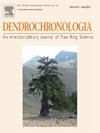秦岭首次基于树轮蓝强度的温度重建
IF 2.7
3区 农林科学
Q1 FORESTRY
引用次数: 0
摘要
重建历史温度对于理解气候历史和预测未来变化至关重要。传统的替代方法,如树木年轮宽度、稳定同位素和x射线密度,可能会受到温度信号捕获差或成本高的限制,而树木年轮中出现的蓝色强度(BI)为低纬度温度重建提供了有效的替代方法。本文首次引入BI来研究油松的气候信号。来自秦岭(QLM)。基于油松样本建立了树轮宽度(TRW)、早木BI (EWBI)、晚木BI (LWBI)和三角洲BI (DeltaBI)年表,利用EWBI年表成功重建了过去174年2 - 6月平均最高气温(Tmax2-6)异常,解释方差为43.56 %。主要发现包括:1)QLM中树木年轮BI数据比TRW数据保留了更强的气候信息。2)重建结果表明,青海经历了3个显著暖期(1871 ~ 1892年、1898 ~ 1931年和2012 ~ 2020年)和3个显著冷期(1856 ~ 1864年、1939 ~ 1965年和1976 ~ 1996年)。新的重建与附近的温度重建和气候网格数据一致,记录了黄土高原西部和QLM相似的温度波动。3) qm Tmax2-6的变化与大尺度气候振荡,特别是太平洋年代际涛动(PDO)和大西洋多年代际涛动(AMO)之间存在显著联系。这项研究肯定了树木年轮BI在QLM气候研究中的效用,为类似的低纬度地区提供了有益的见解。本文章由计算机程序翻译,如有差异,请以英文原文为准。
The first temperature reconstruction based on tree-ring blue intensity in the Qinling Mountains
Reconstructing historical temperatures is crucial for understanding climate history and predicting future changes. While traditional proxies such as tree-ring width, stable isotopes, and X-ray density, may be limited by poor temperature signal capture or high costs, the emerging blue intensity (BI) in tree rings provides an effective alternative for low-latitude temperature reconstruction. Here for the first time, we introduce BI to examine the climatic signals in Pinus tabulaeformis Carr. from the Qinling Mountains (QLM). We develop chronologies for tree-ring width (TRW), earlywood BI (EWBI), latewood BI (LWBI), and Delta BI (DeltaBI) based on P. tabulaeformis samples, and then successfully reconstruct the mean February–June maximum temperature (Tmax2–6) anomalies over the past 174 years using the EWBI chronology, with an explained variance of 43.56 % for the observed data. Our key findings include: 1) Tree-ring BI data in the QLM retains stronger climatic information than the TRW data. 2) Our reconstruction reveals that QLM experienced three significant warm periods (1871–1892, 1898–1931, and 2012–2020) and three cold periods (1856–1864, 1939–1965, and 1976–1996). The new reconstruction aligns with nearby temperature reconstructions and climate grid data, documenting similar temperature fluctuations in the western Loess Plateau and the QLM. 3) It suggests a significant link between Tmax2–6 variations in the QLM and large-scale climate oscillations, specifically the Pacific Decadal Oscillation (PDO) and the Atlantic Multidecadal Oscillation (AMO). This study affirms the utility of tree-ring BI for climate research in the QLM, offering insights that benefit similar low-latitude areas.
求助全文
通过发布文献求助,成功后即可免费获取论文全文。
去求助
来源期刊

Dendrochronologia
FORESTRY-GEOGRAPHY, PHYSICAL
CiteScore
5.50
自引率
13.30%
发文量
82
审稿时长
22.8 weeks
期刊介绍:
Dendrochronologia is a peer-reviewed international scholarly journal that presents high-quality research related to growth rings of woody plants, i.e., trees and shrubs, and the application of tree-ring studies.
The areas covered by the journal include, but are not limited to:
Archaeology
Botany
Climatology
Ecology
Forestry
Geology
Hydrology
Original research articles, reviews, communications, technical notes and personal notes are considered for publication.
 求助内容:
求助内容: 应助结果提醒方式:
应助结果提醒方式:


